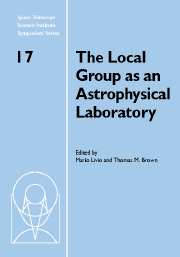 The Local Group as an Astrophysical Laboratory
The Local Group as an Astrophysical Laboratory Book contents
- Frontmatter
- Contents
- Participants
- Preface
- History of the Local Group
- Primordial nucleosynthesis
- Galactic structure
- The Large Magellanic Cloud: Structure and kinematics
- The Local Group as an astrophysical laboratory for massive star feedback
- Hot gas in the Local Group and low-redshift intergalactic medium
- Stages of satellite accretion
- The star formation history in the Andromeda halo
- Bulge populations in the Local Group
- The Local Group as a laboratory for the chemical evolution of galaxies
- Massive stars in the Local Group: Star formation and stellar evolution
- Massive Young Clusters in the Local Group
- Magellanic Cloud planetary nebulae as probes of stellar evolution and populations
- The old globular clusters: Or, life among the ruins
- Chemical evolution models of Local Group galaxies
Primordial nucleosynthesis
Published online by Cambridge University Press: 12 May 2010
- Frontmatter
- Contents
- Participants
- Preface
- History of the Local Group
- Primordial nucleosynthesis
- Galactic structure
- The Large Magellanic Cloud: Structure and kinematics
- The Local Group as an astrophysical laboratory for massive star feedback
- Hot gas in the Local Group and low-redshift intergalactic medium
- Stages of satellite accretion
- The star formation history in the Andromeda halo
- Bulge populations in the Local Group
- The Local Group as a laboratory for the chemical evolution of galaxies
- Massive stars in the Local Group: Star formation and stellar evolution
- Massive Young Clusters in the Local Group
- Magellanic Cloud planetary nebulae as probes of stellar evolution and populations
- The old globular clusters: Or, life among the ruins
- Chemical evolution models of Local Group galaxies
Summary
The primordial abundances of deuterium, helium-3, helium-4, and lithium-7 probe the baryon density of the Universe only a few minutes after the Big Bang. Of these relics from the early Universe, deuterium is the baryometer of choice. After reviewing the current observational status of the relic abundances (a moving target!), the baryon density determined by big bang nucleosynthesis (BBN) is derived. The temperature fluctuation spectrum of the cosmic background radiation (CBR), established several hundred thousand years later, probes the baryon density at a completely different epoch in the evolution of the Universe. The excellent agreement between the BBN- and CBR-determined baryon densities provides impressive confirmation of the standard model of cosmology, permitting the study of extensions of the standard model. In combination with the BBN- and/or CBR-determined baryon density, the relic abundance of 4He provides an excellent chronometer, constraining those extensions of the standard model which lead to a nonstandard early-Universe expansion rate.
Introduction
As the hot, dense, early Universe rushed to expand and cool, it briefly passed through the epoch of big bang nucleosynthesis (BBN), leaving behind as relics the first complex nuclei: deuterium, helium-3, helium-4, and lithium-7. The abundances of these relic nuclides were determined by the competition between the relative densities of nucleons (baryons) and photons and, by the universal expansion rate. In particular, while deuterium is an excellent baryometer, He provides an accurate chronometer.
- Type
- Chapter
- Information
- The Local Group as an Astrophysical LaboratoryProceedings of the Space Telescope Science Institute Symposium, held in Baltimore, Maryland May 5–8, 2003, pp. 16 - 32Publisher: Cambridge University PressPrint publication year: 2006


